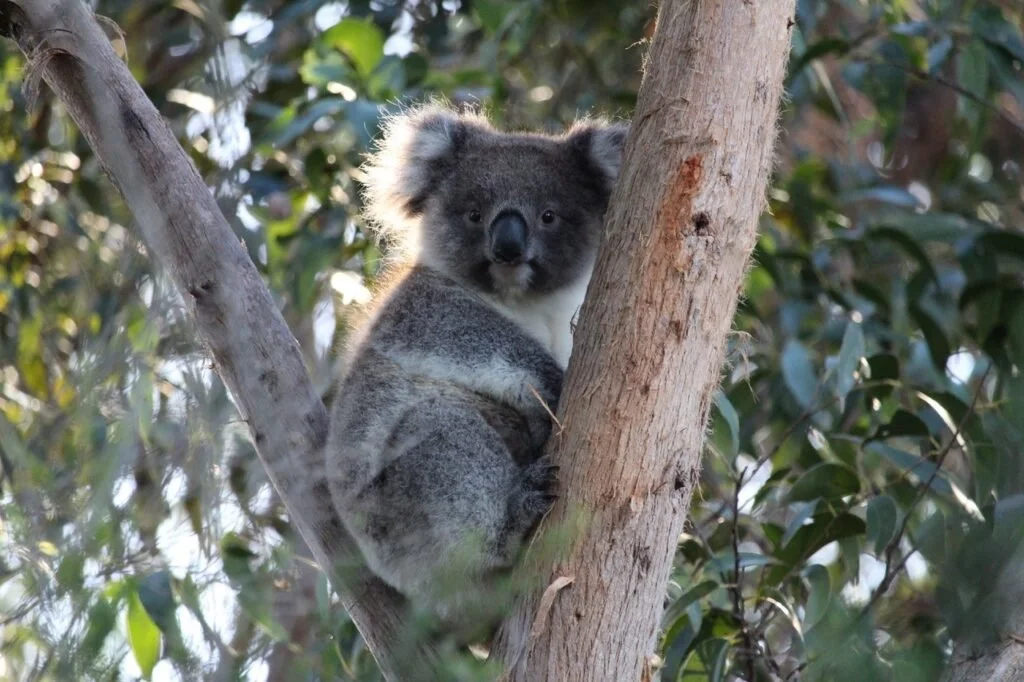How to make your next koala spotting extra special.
While most Australians have seen a koala or two (or many) in their lifetime, it’s still exciting to spot one - and even more exciting we think, when you know more about them.
The sanctuary here at Wildlife Wonders is fully fenced to protect small mammals like potoroos and bandicoots from predation by foxes and cats, but animals like koalas, possums, gliders and birds love to jump, climb or fly in and out as they please. Koalas love it here, so we have a growing population who choose to stay and call the sanctuary home, meaning there’s a good chance you will see one on a tour. All you have to do is look up! But don’t worry, our Nature Guides are experts at koala spotting.
While koalas are cute, there are so many other cool and interesting things to know about them.
Koalas sleep a lot for a reason
Seeing a koala for the first time, chances are, it will be asleep. Koalas need to sleep for around 18 - 20 hours…every single day. A koala’s diet consists only of eucalyptus (or gum) leaves. These gum leaves contain toxic compounds, which are toxic if you or I ate them, but not koalas, they love them. This is part of why they sleep so much, to help digest the toxins from the leaves.
Sleeping koala
Koalas have 2 thumbs
Koalas are really great climbers. While they may seem round and slow, they can quickly climb to great heights. They have 2 thumbs on each of their front paws and grippy pads with claws that make them amazing climbers.
2 thumbs
A koalas bum is perfectly designed to sit in a fork of a tree
Koalas have a kind of cartilage plate in their backsides that helps them sit comfortably in forks of trees. This is one of the tips when looking for koalas, look for forks in trees, and if you see a round lump, that’s probably a koala!
Koala perched on a skinny branch
Koalas aren’t bears
They actually don’t have much in common with bears at all. The correct term is just ‘koala’. Koalas are marsupials and actually have more in common with kangaroos than bears – their closest living relative is the wombat.
Koalas can jump!
Yes you heard right. Koalas don’t seem very agile, but one way to travel from tree to tree or branch to branch, is to jump. Koalas can launch themselves a few feet quite easily.
Koalas have joeys and pouches just like kangaroos
Koalas are marsupials, meaning they give birth to live young. In a koala’s case, they give birth early to a tiny, blind, pink jelly bean size joey, who instinctively climbs straight into its mothers pouch, latches onto a teat and spends a number of months feeding on milk until it’s big enough to come out. Once it’s out, it will ride on mum’s belly or back, unlike kangaroo joeys who will stay in their mum's pouch until they are quite big, legs poking out and all!
How to tell if it’s a male or female koala
Males will be a bit larger than females, but that’s hard to tell when you’re looking at just one (which is usually the case). The easiest way to tell them apart is looking for a brown tint that may be on a male koala’s white chest. Male koalas leave their mark on trees by rubbing on it with their scent gland on their chest, often getting a bit stained in the process. This is to mark their territory, or to communicate with potential mates.
Female koala
Male koalas can sound like dinosaurs
While female koalas have a range of quieter, still quite strange sounds they use to communicate different things, the male call is very distinctive. The loud, low, continuous grunt of a male koala calling a mate could be mistaken for a much larger, scarier animal…even perhaps a dinosaur.
Koala perched in a fork of a tree
Top 4 koala spotting tips from our Nature Guides
It’s always exciting seeing a koala and our Nature Guides are expert koala spotters! Some of their tips are:
Always look higher than you may think, koalas are great climbers.
Keep an eye out for koala scat on the path (that smells like eucalyptus).
Trace your eyes up a tree looking for forked branches, koalas often perch in these.
They aren’t always easy to spot, but if you see a big, round lump in a tree, that’s probably a koala sleeping.
We hope to see you soon for some koala spotting!





